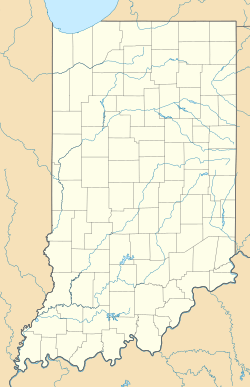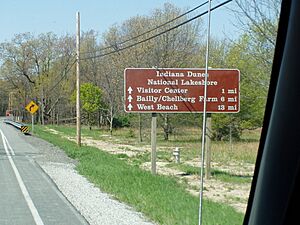Tremont, Indiana facts for kids
Quick facts for kids
Tremont
|
|
|---|---|

Tremont business district, circa 1920s
|
|
| Country | United States |
| State | Indiana |
| County | Porter |
| Township | Westchester |
| Established as New City West | 1833 |
| Refounded as Tremont | 1908 |
| Abandoned | 1960s |
Tremont, Indiana, is a ghost town. This means it was once a busy place but is now mostly empty. It used to be in what is now the Indiana Dunes State Park and Indiana Dunes National Park in northern Porter County, Indiana.
It was started way back in 1833. You could find it where U.S. Highway 12 and County Road 100 East met, close to Indiana 49. The town got its name from three huge sand dunes nearby. These dunes are Mount Tom (about 61 meters tall), Mount Holden (about 52 meters tall), and Mount Green (about 49 meters tall). Today, these dunes are part of the State Park.
History of Tremont
Early Days as New City West
Tremont was first known as New City West. It was named after a nearby town called City West, Indiana. City West was on the shore of Lake Michigan and seemed like it would become a big port city, even bigger than Chicago at the time.
However, in 1837, a big economic problem called the Panic of 1837 hit. City West was abandoned and later burned down. Even though its namesake was gone, New City West kept the City West Post Office and School. About 20 houses were built there, along with a sawmill, a shop that made barrels, and a brickyard.
In 1853, the City West Post Office joined with the Calumet Post Office. A place called the Alanson Green Tavern became popular for tourists in the 1850s and 1860s. Travelers would eat there while their stagecoach drivers changed horses. During this same time, New City West was an important stop on the Underground Railroad. This was a secret network that helped enslaved people find freedom.
But in 1875, the sawmill in New City West was destroyed by a boiler explosion. After this, the town stopped growing and was mostly empty by 1876.
Becoming Tremont
By 1908, New City West started to be called Tremont. This was because a new train station with that name was built there. It was on the South Shore Line, an electric train route that went through the Indiana Dunes. This train line was very important for Tremont.
Because the town was so close to the railway, Tremont is often mentioned in stories about the Dunes. For example, a famous landscape designer named Jens Jensen and his friends built a beach house there in 1913. By 1929, most of the old New City West buildings were gone. But new buildings were put up, and the area became a popular summer resort town called Tremont.
Tremont was never officially a city, but it grew quite a bit in the early 1900s. It even had its own train station for people who commuted to work. However, in the 1960s, the Indiana Dunes National Lakeshore was created. The government bought up land in the area, and the remaining people in Tremont had to move away.
Tremont's Legacy
The Indiana Dunes, including the Tremont area, helped inspire people to protect nature. This led to the creation of groups like The Nature Conservancy.
Part of the old village of Tremont is still used today. The main building and station for the South Shore Line (NICTD) are right next to where the old town center was. The original Tremont train station was a bit east of where the current Dune Park station is now.



